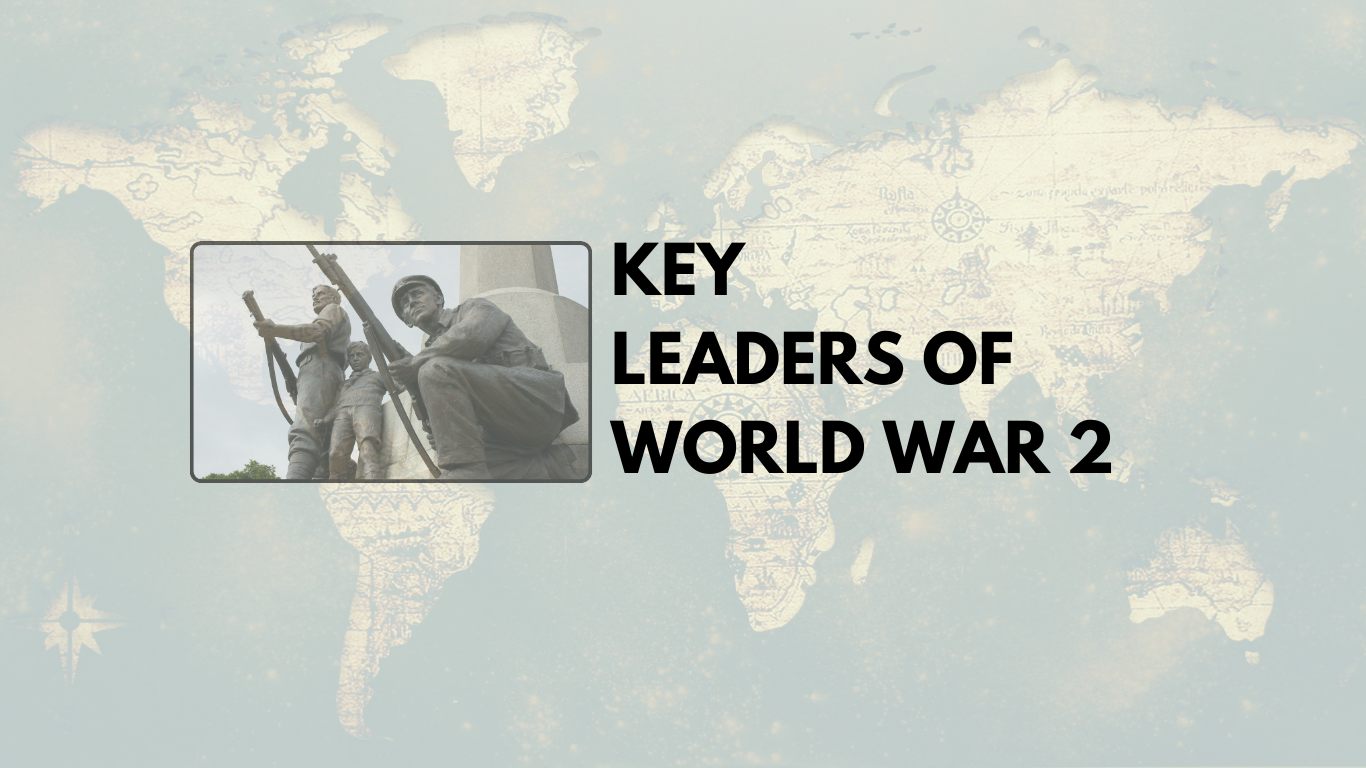
Key leaders shaped World War 2 by making decisions that changed the course of history. Some led their nations to victory, while others dragged the world into chaos. The Allied leaders stood against tyranny, while the Axis leaders sought domination. Let’s break it down.
Allied Leaders
Franklin D. Roosevelt (USA) – The War-Time President
When Japan bombed Pearl Harbor in 1941, Roosevelt didn’t hesitate. He called it a “day that will live in infamy” and pushed the U.S. into World War 2. His leadership? A game-changer.
- Lend-Lease Act: Armed the Allies, keeping the UK and USSR in the fight.
- War Strategy: Focused on defeating Germany first, then turning to Japan.
- Yalta Conference: Negotiated with Stalin and Churchill to shape post-war Europe.
Without Roosevelt, the Allies might not have won. But he died before seeing Nazi Germany fall.
Winston Churchill (UK) – The Voice of Defiance
Britain stood alone in 1940. France had fallen. The Luftwaffe bombed London daily. But Churchill? He refused to surrender.
- Battle of Britain: His speeches inspired the RAF to hold off Hitler’s air force.
- Close Ties with Roosevelt: Secured American aid before the U.S. entered the war.
- D-Day Planning: Backed the Normandy invasion, leading to Nazi Germany’s downfall.
Churchill never quit. He saw World War 2 through to the end, even when Britain was on its knees.
Joseph Stalin (USSR) – The Relentless Dictator
Stalin was ruthless. But he was also the reason Germany lost the Eastern Front.
- Battle of Stalingrad: His troops crushed the Nazis in one of history’s bloodiest battles.
- Soviet War Machine: Relocated factories east, producing tanks faster than Germany.
- Tehran & Yalta Conferences: Negotiated with Roosevelt and Churchill to split Germany after the war.
The Red Army stormed Berlin in 1945. Stalin’s revenge was brutal. The war against Hitler cost the USSR over 20 million lives.
Axis Leaders
Adolf Hitler (Germany) – The Architect of Destruction
Hitler didn’t just start World War 2. He engineered the Holocaust, built a war machine, and nearly conquered Europe. But he also made fatal mistakes.
- Blitzkrieg Tactics: Overran Poland, France, and the Soviet Union at lightning speed.
- Operation Barbarossa: Invaded the USSR, but underestimated the Soviet winter.
- D-Day & Defeat: His refusal to retreat led to the fall of Berlin in 1945.
In the end, Hitler took his own life. Germany surrendered days later.
Benito Mussolini (Italy) – The Failed Dictator
Mussolini wanted a new Roman Empire. But his military was weak. His leadership? Disastrous.
- Invasion of Ethiopia: Showed his imperial ambitions but lacked real military strength.
- Weak War Effort: Needed constant help from Germany to keep his troops afloat.
- Overthrown & Executed: Captured by Italian partisans and executed in 1945.
Mussolini dragged Italy into a war it wasn’t ready for. His dream ended with him hanging upside down.
Emperor Hirohito (Japan) – The Silent Monarch
Hirohito ruled Japan, but the real power was with his generals, like Hideki Tojo. Still, he played a key role in the war’s outcome.
- Pearl Harbor Attack: His navy launched the surprise strike that brought the U.S. into the war.
- Pacific War: Japan seized huge territories but underestimated American firepower.
- Surrender: After the atomic bombings of Hiroshima and Nagasaki, he announced Japan’s surrender.
Hirohito remained emperor after the war, but Japan’s era of military rule was over.
Other Influential Leaders in WW2
Allied Side
- Dwight Eisenhower (USA): Supreme commander of the D-Day invasion.
- Douglas MacArthur (USA): Led the war in the Pacific, promised to “return” to the Philippines.
- Charles de Gaulle (France): Led the Free French Forces, fought from exile after France fell.
Axis Side
- Hideki Tojo (Japan): Prime Minister, mastermind behind Japan’s war strategy.
- Hermann Göring (Germany):Luftwaffe chief, lost the Battle of Britain.
- Heinrich Himmler (Germany): Oversaw the Holocaust, one of history’s greatest war criminals.
Leadership Styles and Strategies
Each leader had a different style:
- Roosevelt & Churchill: Master communicators who kept morale high.
- Stalin & Hitler: Dictators who ruled through terror and propaganda.
- Mussolini & Hirohito: Lacked the control to win a total war.
In the end, World War 2 was won by strategy, resilience, and sheer force.
Impact and Legacy
The war ended in 1945, but these leaders shaped the world for decades:
- United Nations formed – A direct result of Allied leadership.
- Cold War began – Stalin’s Soviet Union became the new global rival.
- Germany and Japan rebuilt and turned into economic superpowers under Allied guidance.
The decisions made by the key leaders of World War 2 still shape our world today.